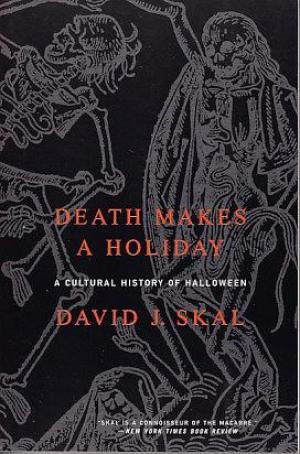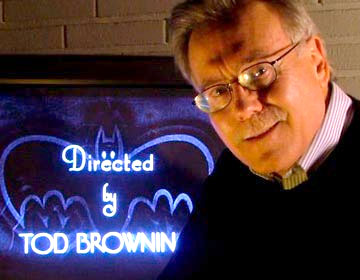 By DAVID J. SKAL (Bloomsbury; 2002)
By DAVID J. SKAL (Bloomsbury; 2002)
The second of author David J. Skal’s “Cultural Histories.” The first was 1993’s THE MONSTER SHOW, which took a rambling yet thoroughly enjoyable look at horror media that encompassed such disparate topics as the AIDS epidemic, Fangoria conventions and the CARRIE musical. DEATH MAKES A HOLIDAY takes a similarly esoteric approach to its subject: Halloween.
Skal begins the book with the story of Ronald Clark O’Brien, who on Halloween night, 1974 murdered his eight year old son Timothy with a cyanide-filled pixie stick. This, Skal claims, had the effect of accelerating the already-prevalent myth of tainted Halloween candy, which has ballooned steadily in the ensuing decades. That, of course, is in stark contrast to the family-friendly bent Halloween has taken on, something that definitely isn’t lost on Skal.
Provided is a good history of the holiday, which “has its essential roots in the terrors of the primitive mind.” Specifically the Celts, who originated the festival of Samhain, and the Romans, who brought the November 1 festival of Pomona to Britain. Further landmark holidays, such as Guy Fawkes Day and the Feast of All Saints and All Souls’ Days, have coalesced into the Halloween we all know, a “kind of cultural Frankenstein stitched together quite recently from a number of traditions, all fused beneath the cauldron-light of the cultural melting pot.”
…a “kind of cultural Frankenstein stitched together quite recently from a number of traditions, all fused beneath the cauldron-light of the cultural melting pot.”
 Skal roams quite freely over the Halloween landscape. Included are chapters on modern-day Salem, MA, which has embraced its dark history of witchcraft trials quite readily, as well as the “Yard Haunting” DIY haunted house craze, the infamously rowdy gay Halloween parades of San Francisco and other major American cities, HALLOWEEN (1978) and its sequels, and the intersection of Halloween and the events of September 11, 2001 (still current when this book was being written), which apparently “reconnected the holiday to some of its forgotten spiritual roots.” Also featured are interviews with Clive Barker and Fangoria’s Anthony Timpone, and sixteen pages of photos and illustrations.
Skal roams quite freely over the Halloween landscape. Included are chapters on modern-day Salem, MA, which has embraced its dark history of witchcraft trials quite readily, as well as the “Yard Haunting” DIY haunted house craze, the infamously rowdy gay Halloween parades of San Francisco and other major American cities, HALLOWEEN (1978) and its sequels, and the intersection of Halloween and the events of September 11, 2001 (still current when this book was being written), which apparently “reconnected the holiday to some of its forgotten spiritual roots.” Also featured are interviews with Clive Barker and Fangoria’s Anthony Timpone, and sixteen pages of photos and illustrations.
Included are chapters on modern-day Salem, MA, which has embraced its dark history of witchcraft trials quite readily…
As in THE MONSTER SHOW, DEATH MAKES A HOLIDAY’s overall effect is pleasing and enjoyable. Skal, who got his start as a novelist, has a lively prose style and a strong grasp of storytelling mechanics, which prove quite useful in rendering this highly scattershot account in a lively and streamlined manner.

